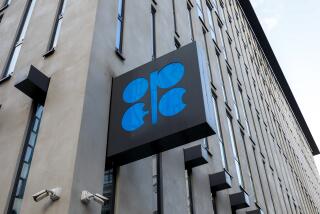OPEC Could Agree to Cut Output, Experts Say
- Share via
LONDON — OPEC is in disarray, but falling petroleum prices do not necessarily mean the cartel is out of the driver’s seat, market experts said Tuesday.
Even as Middle East crude quotes dipped under $10 a barrel, several observers were ready to bet that OPEC meetings due late in November might clinch an elusive agreement on production controls to mop up the excess output that now weighs on the market.
The current glut may mean cheaper home heating this winter and some relief on industry’s fuel bills. But gasoline prices are less likely to decline much, because of high taxes at the pump in many nations and, in the United States, vigorous demand.
Some market analysts believe a firmer oil market may be seen in 1989.
“I think there is a pretty good chance that OPEC will strike a deal on production at the November meeting,” said Michael Unsworth, oil analyst with London brokerage Smith New Court.
The latest slide in oil prices follows weekend talks in Madrid by eight of the 13 cartel ministers who met to prepare for the full conference on Nov. 21.
“The oil market expectations from the Madrid meeting were too high,” said John Crowley at Chase Manhattan in London. “It was looking for a new agreement on production quotas out of it. The true picture is that enormous progress was made.”
Crowley agreed with Algerian Oil Minister Belkacem Nabi, who said the significance of the joint session in Madrid of OPEC’s pricing and long-term strategy committees was that erstwhile Persian Gulf war foes Iran and Iraq at least talked to each other, even if they failed to agree.
OPEC’s biggest problem has been a demand by Iraq to be given as big a mandatory output quota as Iran. Iran, historically a bigger producer, has rejected that, leading Iraq to stay out of cartel-output agreements altogether.
With Iraq flouting the rules, other members have felt few inhibitions about producing more than cartel rules allow.
European oil traders said the current price slide was led by the Japanese, who took a more “bearish” view of the Madrid talks.
The benchmark Middle East crude, from Dubai, has plunged by more than $1.80 to around $9.85 in Asia since Sunday after being above that psychologically important level for almost two weeks.
“There was a common feeling that OPEC failed to achieve anything,” said a Tokyo trader. “If they had had a consensus on any point, they would have issued a communique.”
But even in Japan, there is a view that further price declines may stampede OPEC in November into an output pact that all 13 cartel members can agree to abide by.
“I think that they need another dollar decline before they can come to any comprehensive agreement,” said one refiner.
Unsworth of Smith New Court calls it “the OPEC greed/fright index.”
A soft oil market has prevailed through the 1980s, ever since sky-high prices in the previous decade drove the West to conserve energy and tap new oil basins outside OPEC control.
Unsworth points out that on several past occasions, last in 1986, OPEC overproduced but then was scared back into a quota agreement by sagging prices.
But he says that it will require fine judgment to set a 1989 ceiling for its overall output, which has now risen out of control above 21 million barrels daily.
A surplus of more than a million barrels daily is entering the industry’s inventory, and could flow to the market next year. Most experts say a total OPEC output of 19 million barrels daily should be sufficient to tighten the market.
“Demand has been growing by about 2% for the past three years,” Unsworth said. “Next year it might grow more slowly, by about 1.5%. Nineteen million might do it, but it might not.”
Chase Manhattan’s Crowley said: “There is a general feeling that all 13 OPEC members including Iraq might be accommodated in a ceiling somewhere around 19 million barrels a day.”
But estimates of demand vary, and stocks are high, he added. Still, if OPEC did cut to 19 million barrels, it might get prices back up to around $15 a barrel next year.
While Middle East oil fell below $10 Tuesday, North Sea Brent Blend--richer in gasoline and the most widely traded crude--was quoted just above $12 in Europe. In New York, Brent was at $12.335 for December loading. It is down more than $1 from last week but is above 26-month lows of $11.20 touched on Oct. 6.
In New York, West Texas Intermediate for December delivery closed up 9 cents at $13.26 after falling $1.20 on Monday.
More to Read
Inside the business of entertainment
The Wide Shot brings you news, analysis and insights on everything from streaming wars to production — and what it all means for the future.
You may occasionally receive promotional content from the Los Angeles Times.










